The 10 Biggest Indiana Jones Rip-offs
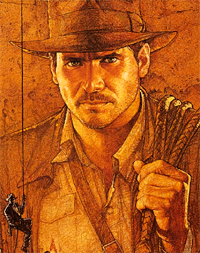 By Todd Ciolek
By Todd Ciolek
Raiders of the Lost Ark did more than just introduce Indiana Jones and turn Steven Spielberg and George Lucas into Hollywood royalty. It also brought upbeat, half-silly 1930s serial adventures back to life, inspiring everyone from moviemakers to game developers to copy the film?s style and its roguish, whip-cracking hero.
And copy it they did. Raiders and its two sequels touched off a pop-culture explosion that spawned imitators for decades to come, some okay, and others merely horrible. Topless Robot has sat down to decide which of them are the most obvious about it.
10) Earnest Evans
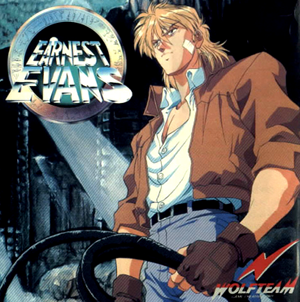
Video games had no fear of copyright law back in the age of the Sega Genesis. Take Earnest Evans, the star of a three-game series created by the workhorse Japanese developer Wolf Team. Earnest has Indy?s fashion sense, his whip, his gruffly efficient manner, his Prohibition-era sense of adventure, and his penchant for trekking around the globe to beat back ancient horrors. Still, Earnest has a few things Indy doesn?t: a flowing blond mullet, a variety of Lovecraft-inspired monsters to fight, and a green-haired Peruvian girl named Annet to tag along with him.
And Earnest did something Indy would never do: he let a woman upstage him. Earnest wasn?t even the star in his first game appearance: El Viento, a 1991 action-platform deal for the Genesis, focused on Annet fighting mobsters and demons while Earnest merely put in a cameo or two.
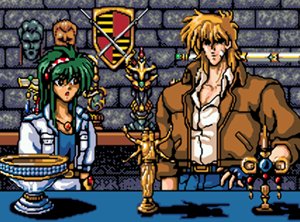
Earnest didn?t get the lead until El Viento?s considerably worse prequel, simply called Earnest Evans, arrived on the Sega CD (and, in cut-down form, on the Genesis). No one noticed. So great was Earnest?s emasculation that the last title in the alleged ?Earnest Evans Series? put Annet back in the spotlight and called itself Annet Again. When you think about it, Earnest is actually Annet?s sidekick.
9) Montana Jones
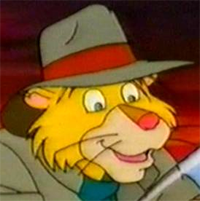
Just about every lazily written cartoon of the ?80s or ?90s had its own little Indiana Jones parody, usually under titles like ?Pasadena Jones.? Yet it fell to an alliance between anime studios and Italian producers to make an entire series about a leonine explorer named Montana Jones and ship it to easily entertained children around the world.
Fueled by the same thinking that gave us such cartoons as Sherlock Hound and Dogtanian and the Muskehounds, Montana Jones uncreatively thrust the Indy ethos into a world of 1920s cat-people, complete with steampunk embellishments like giant mechanical elephants. Though it limped through over 60 episodes and even inspired an (awful) game for the Panasonic 3DO, Montana Jones never came to the U.S., perhaps because 1994 was long past the sell-by date when it came to American kids and furry versions of Indiana Jones.
8) Frank Buck from Bring ?Em Back Alive
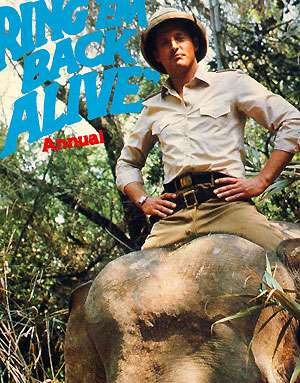
The real-life Frank Buck was an animal trapper who found fame by catching defenseless creatures and appearing in jungle-adventure movies of the 1930s. It?d be tough to call him an Indiana Jones rip-off, seeing as how Raiders of the Lost Ark didn?t come out until 1981. But when TV producers at CBS decided that they wanted a piece of the Indiana Jones pie, they went straight to Frank Buck?s legacy.
Granted a TV series and some very, very Raiders-ish music, the ?80s version of Frank Buck was paired with an exasperated Asian sidekick and a brainy blonde romantic interest, predating The Temple of Doom?s similar supporting cast by a year or so. Buck himself was played by Bruce Boxleitner, fresh from the glowing, empty computer-scapes of Tron. In a safari hat and ridiculous shorts, Boxleitner?s Buck approached the show as a comedy, and the movie-lot production values put no one in danger of taking it seriously. Bring ?Em Back Alive ended in 1983 after one season, and Boxleitner went on to Scarecrow and Mrs. King and Babylon 5, neither of which had him wearing shorts.
7) Jack T. Colton from Romancing the Stone
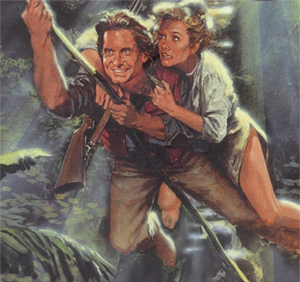
Romancing the Stone slides around accusations of aping Indiana Jones by pitching itself as metafictional fantasy fulfillment by a mousy romance novelist (Kathleen Turner), who effectively lives out one of her books on a South American odyssey. There?s a criminal conspiracy, a treasure hidden in an ancient temple, and, of course, a dashing man of the world to sweep her off her feet.
Jack T. Colton (Michael Douglas) isn?t an archeologist or even an accredited professor at some community college, but he?s still enrolled at the Indiana Jones school of sex appeal, the same school that made women love Harrison Ford and sit through The Mosquito Coast. Romancing also has a bit of Lucas-style comedy relief in Danny Devito, who plays a bumbling crook and, like Lucas? most annoying characters, survives too much of the film.
6) Lara Croft from Tomb Raider
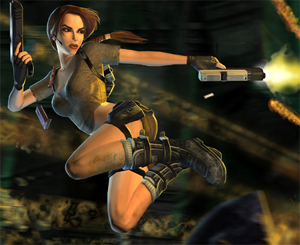
If anyone charged Lara Croft with swiping from Indiana Jones when she emerged on the market in 1996, such criticisms were rapidly forgotten as the buxom explorer established the Tomb Raider series as a hit and herself as a gaming icon. In all fairness, Croft?s creators at Core couldn?t be faulted for taking the concept of a male action hero and giving it gigantic breasts. The comic industry?s done it for decades.
If we were pretentious types trying to squeeze out a term paper, we could say that Lara serves as a feminist response to the sexist patriarch-type of globe-traversing Indy clones, as her rival in the original Tomb Raider is very much a ruder, redneck mockery of the rugged Dr. Jones. But then we?d feel silly.
—-
5) Allan Quatermain from King Solomon?s Mines
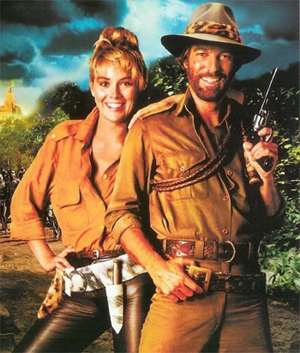
Anyone who took English Pulp Literature 101 is likely ready to tell us that Allan Quatermain was introduced in King Solomon?s Mines and other books by H. Rider Haggard over 100 years before Indiana Jones and that, if anything, Indy is a rip-off of Quatermain and that we?re all morons here. But we?re talking about the Allan Quatermain from the 1985 Hollywood version of King Solomon?s Mines, which certainly would never have been made without Raiders to pave the way.
This Quatermain is a bit different from his literary source, as both King Solomon?s Mines and its horrible sequel, Allan Quatermain and the Lost City of Gold, parody the whole idea behind Indiana Jones and the old-fashioned Quatermain, neither of whom ever had to escape a tribe of cannibals by rolling downhill in a huge cooking pot with Sharon Stone. And yet the ?80s Quatermain is still more dignified than the one in The League of Extraordinary Gentlemen movie. [Ed’s note: Holy Shit! It’s narrated by Optimus Prime!]
4) Explorer Woman Ray
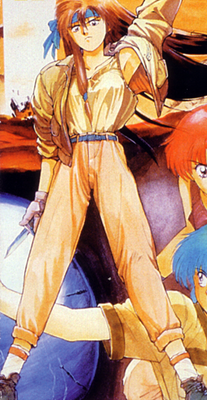
The ?80s were a magical time for Japan?s animation industry, when the nation?s bloating economic bubble allowed it to turn any idea into brief direct-to-video anime, no matter how horrible or derivative it was. The batshit-insane Crystal Triangle starred an Indy analogue, but it was outdone by Explorer Woman Ray. Not only is Ray?s title explorer-woman a part-time university professor who metes out two-fisted archaeological justice, but her biggest rival, Rig Veda, is an anime version of Belloq, Indy?s nemesis from Raiders of the Lost Ark.
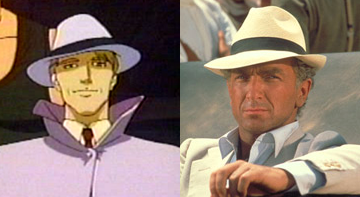
See? As you might expect, Not-Belloq and Ray squabble over the secrets of an ancient society while two kids, each more annoying than Short Round, get in the way. Sorry, Spielberg and Lucas. Again we see there is nothing you can possess which anime cannot shamelessly steal.
3) Feed Sluster from Fiend Hunter
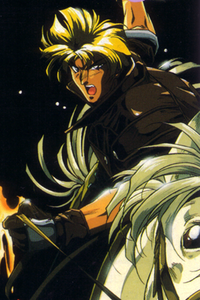
Feed is an Indiana Jones rip-off twice removed, as he?s directly patterned on Earnest Evans (see above). Yet Feed still has plenty of Jones-like qualities, from his leather jacket to his horseback rides toward ancient civilizations, and we?ll overlook the fact that he shuns a whip in favor of a big-eyed Will-o-the-Wisp sidekick that turns into an electric sword. He also has the most ridiculous name in Japanese game history, and that?s saying a lot.
Feed?s first and only appearance came in a 1994 TurboDuo action game called Fiend Hunter, which actually manages to be worse than Earnest Evans. It does, however, feature lots of animated cutscenes, including a prologue in which Feed declines a heated bedroom romp with a naked woman just so he can ride off with his fireball friend to investigate something.
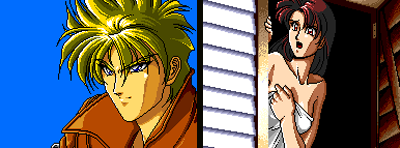
Feed Sluster is even dumber than his name.
2) Jake Cutter from Tales of the Gold Monkey
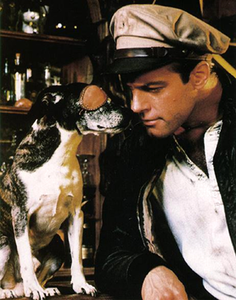
Spielberg and Lucas weren?t the only producers eager to recreate old-fashioned pulp adventure in the late ?70s. Magnum P.I. creator Donald P. Bellisario unsuccessfully pitched Tales of the Gold Monkey to TV execs for years. Then Raiders hit and every network scrambled to match it.
Tales is probably the least direct of every Indiana Jones rip-off, though it has the same sense of 1930s pre-WWII idealism, the same sort of roguish, put-upon hero, and the same occasional burst of ancient mysticism. Maybe that?s why it?s also the most entertaining Indy tagalong. It?s not so much that Jake Cutter runs deadly missions and dodges come-ons from a Japanese mobster princess. It?s that he has a Jack Russell Terrier who wears an eye patch. If The Kingdom of the Crystal Skull doesn?t give Indy an even cuter dog, we?ll be disappointed.
1) Sydney Fox from Relic Hunter
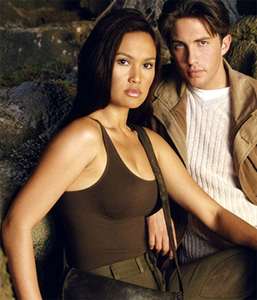
If you ever want to start a fierce debate among pop-culture geeks, ask them to name the worst thing to feature Tia Carrere. You?ll likely hear about Airwolf and Jury Duty and perhaps even the video-driven PC game The Daedalus Encounter, but eventually you?re going to run into Relic Hunter. Less an Indiana Jones copy and more an attempt to bring Tomb Raider to the world of syndicated television schlock, Relic Hunter debuted in 1999 with Carrere as the intrepid Sydney Fox, an archaeologist who dresses in tight, revealing clothes and explores hot, sweaty, cheaply recreated corners of the globe. True to Indiana Jones casting, Sydney has a big university backing her and a collection of inferior, studious assistants to help her on her travels.
We could show you the Relic Hunter opening, but this clip more ably illustrates why the series was made, and why it lasted three whole seasons.
